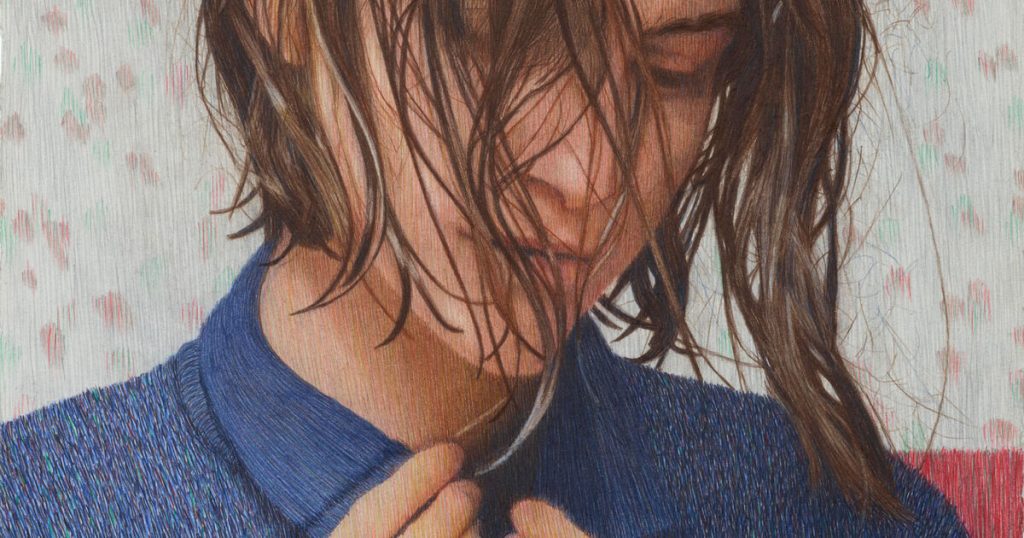Five years ago, Tarka Kings discovered a blissful sanctuary in the middle of London’’s bustling shops and skyscrapers. Situated in Hyde Park, the Serpentine Lido is a natural oasis in one of the world’s busiest cities, visited by wild swimmers and dazzling white swans alike. For her new London exhibition, “Mornings at the Lido,” on view at Offer Waterman, through October 24th, the British artist’s colored pencil and graphite drawings provide an intimate view into moments of transition by the water.
“I have always loved that kind of swimming,” Kings told me ahead of the exhibition opening. For years, she would swim in rivers around Scotland and England, a pastime for every now and then rather than a regular hobby. But when she began to visit the Serpentine “more seriously” with a friend during the pandemic, she became hooked. “After a while, it becomes an addictive thing which you can’t stop,” she said. Kings does not see herself as a swimmer with goals. She is not interested in races or personal records. What she is drawn to is the intensity of the cold water and the physical and emotional buzz that follows. This experience is what inspires her recent body of work, which was a change in direction for the new show. Previously, her dramatic graphite renderings of light through windows and abstract paper cutouts have been shown at galleries including the Royal Academy of Arts and London gallery Pippy Houldsworth.
There has been a surge of interest in wild swimming in the U.K. over the last decade, which for many, can bring greater understanding of nature and its needs. Yet in many areas, this practice is under threat due to sewage dumping in rivers and seas. For Kings, this only “makes it more precious to people.” She enjoys the community aspect of semi-wild swimming, which she describes as a crucial third space for human interaction. Kings finds herself comforted by being in a group of people silently swimming while enjoying the contemplative, solitary space of the water. “It’s an incredibly ancient, natural environment for human beings,” she said. “Hence why baptism happens in water. I imagine that started because we feel so comfortable in it.” Her studio reflects this belief. It is situated on a pontoon on the Thames with a view of the glistening water and boats passing outside her window.
Given this inspiration, it may come as a surprise that none of her drawings for “Mornings at the Lido” feature people actually swimming. She wanted to avoid the typical clichés, she said: wild seascapes or the glamor of loungers by the pool. She enjoys David Hockney’s paintings of swimming pools, but those feel very different from the experience she wished to evoke. Instead, she photographed a close friend changing clothes by the water, celebrating an everyday act that at times feels clumsy and intimate. These photos were the basis for her soft, mindful drawings, which are cropped closely to her model and occasionally feature the surrounding wildlife.
During wild swimming, especially in the winter, the strongest physical sensations are outside the water, Kings explained, as the rush of endorphins surges and the skin begins to feel the cold. This was the moment that was most important for her to capture in her artwork. She sees this as a metaphorical change that happens after swimming. “You really feel your body. In normal life, I don’t feel my body in such a clear way,” she said. Through focusing on this moment of dressing, Kings explores the tension between modesty and exposure that surrounds nudity in art. In Blue Towel (2025), her subject both reveals and conceals her body as she dries herself with a towel.
Kings’s drawings are built up from hundreds of tiny colored marks, creating a hazy aesthetic. These drawings, though focusing on the solid human body, are fluid, their marks dancing before the eyes. This is a time-consuming, meditative process which mirrors the peaceful experience of swimming in wild water.
Kings’s soft style captures the conditions around natural bodies of water as the light shifts or mist hangs over the surface. For this exhibition in particular, Kings was drawn to Post-Impressionist Georges Seurat’s pointillist style, an influence that is obvious from the layered but ultimately individual fine marks of each drawing. Perhaps more surprisingly, she also cited the Op art of Bridget Riley. Kings was fascinated to discover that Riley’s works were informed by watching the sea in Cornwall. “They glitter,” she said. “You look at Riley’s paintings and they are like light on water. They also have a great stillness and clarity.”
Another motif throughout the works on view is swans, which are a key fixture in Hyde Park. A solo black swan appears in By the Lake (2025), for instance, its elegant form reflected in the water, watched over by Kings’s subject as she flicks through a blank book. For Kings, these animals sum up the importance of wild swimming, and the alternative view of nature that it provides. Instead of watching the birds from the banks as a passive and ultimately separate observer, the act of swimming brings people to their level, seeing both the swans and surrounding habitat from their perspective. Crucially, this grants a rare opportunity to be one with nature, tapping into the abundant non-human life that flows even through our busiest cities.
